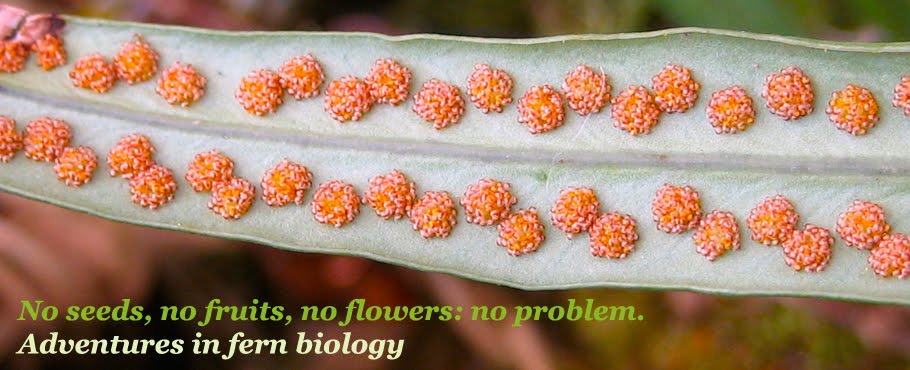Another fern from Costa Rica, this is Sticherus bifidus. I took this particular picture along one of the driveways through the research station at Las Cruces; I was trying to get a good closeup of the little fiddlehead in the fork where the two pinnae meet. I didn't succeed, but this is still a nice view of the growth habit this fern takes. Its leaves fork dichotomously (in two), often several times, and a small "resting bud" (the fiddlehead) sits at the fork ready to begin growing again when the time comes. This is indeterminate growth, as opposed to determinate, where the leaf grows to a certain size and then stops. Often the bud will grow vertically upwards, through other vegetation, and when it overtops its immediate neighbors it will then send out new pinnae to the sides, and the bud will rest until it's time to grow again.
Friday, March 28, 2008
Monday, March 24, 2008
Journey Through Ferns
A friend who knows I study ferns sent me a link to this video on YouTube a few days ago. It's called Journey Through Ferns and was made by a user named artvisionary, who has many vids up similar to this one. It's basically slow fly-over camera work of a lush, beautiful group of ferns, set to some cool background music. It's relaxing, but as the music picks up it also becomes kind of invigorating. Her other videos are similar, of rainforests and early morning bird songs. But of course, the fern one is the best!
The Fern Lover's Companion
I recently found an ebook of George Henry Tilton's 1923 The Fern Lover's Companion: A Guide for the Northeastern States and Canada, which you can download for free here. It's a very beautiful guide and contains lots of illustrations and black-and-white photographs. Some of the taxonomic information is out of date, but it is nonetheless very interesting. It contains some little gems, including a key to the species of Botrychium which explains some of the superstitions associated with the genus:

"Horses that feeding on the grassy hills,
Tread upon moonwort with their hollow heels,
Though lately shod, at night go barefoot home
Their master musing where their shoes be gone."
Among other things, the moonworts were thought to be capable of unshoeing any horse that walked on them, and of unlocking any lock they touched. This book is full of things like that and well worth perusing.

Friday, March 7, 2008
Petiole Vasculature
One fern feature that is useful in identifying a specimen is the pattern of its vascular tissue at the base of the petiole. We talked a lot about this on the fern course in Costa Rica, because it is particularly useful in determining which major group a fern belongs to, which will narrow down the possible families it could be in.
The petiole of a fern is the narrow, stem-looking tissue (that's not actually the stem-the stem is the rhizome) to which the leafy blade is attached. If you clip this stalk right at the base, and look at it through a hand lens or with the naked eye if the fern is large enough, you should be able to see a pattern of lines or circles. These are the vascular bundles, composed of xylem and phloem, which conduct water and sugar through the plant. Certain patterns of the bundles are characteristic of the group of fern you are looking at; the omega shape in the first three photos above can be found in Eupolypods I and a few other groups, while the last image is of Angiopteris, a fern in the more basal family Marattiaceae.
Sunday, March 2, 2008
Hemionitis
Another beautiful fern from Costa Rica, this is Hemionitis palmata, in the Pteridaceae. These fertile fronds were about 3.5 inches across, and shaped a little differently from the non-fertile frond shown at top left (which was also from a different plant). The non-fertile fronds seem to be mostly three-lobed, while the fertile fronds we saw were five-lobed. They are all very soft on the upper (adaxial) surface. The sori lack indusia, and typically form this linear, netted pattern. The common name of this species is 'starfern'.
Subscribe to:
Comments (Atom)








